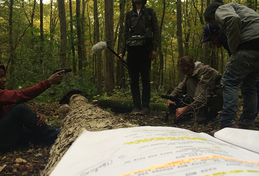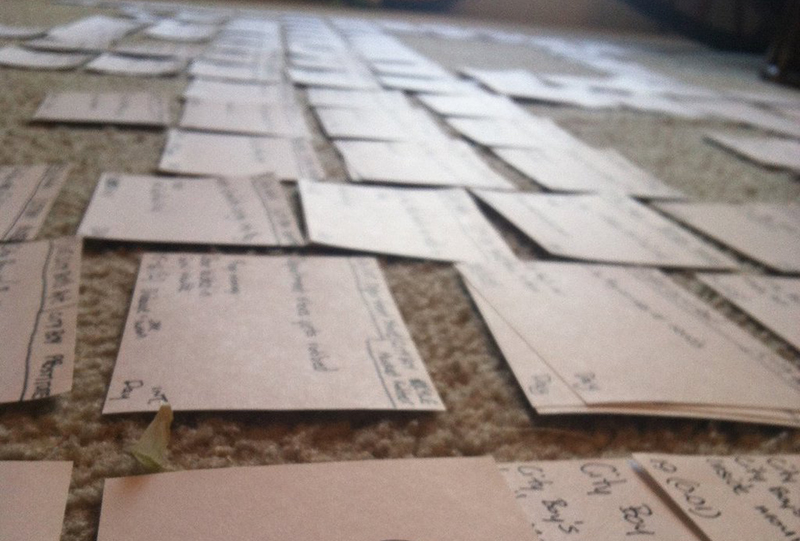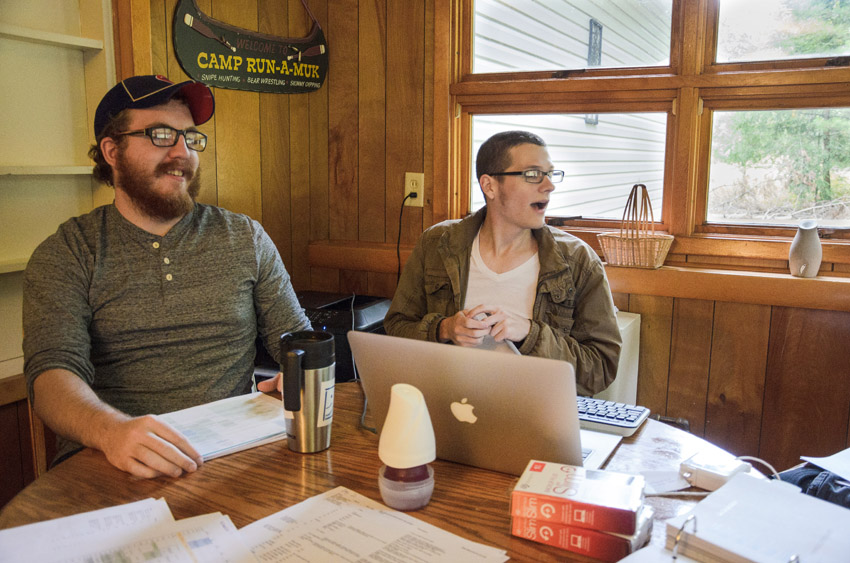 I drove home from Philadelphia, barely able to stay awake on the turnpike. We had just completed a feature film, Blood on the Leaves, in the prior 13 days. Although I was a producer of the film (so my experience may have been slightly different than most), this was my first time working as an Assistant Director. I think it's valuable to share my experience, because most of the information out there is about being an AD on low-budget to full-budget feature films or TV shows; the experience working on a micro-budget film as the only member of your department is quite different. I bounce around positions a lot. It's not abnormal at the micro-budget range I usually work in. I'm a producer, cinematographer, editor, visual effects artist, and sometimes director. When we were sitting down in our producer's meetings for Blood on the Leaves, it was assumed at first that I would be the cinematographer-- we were working with the same team that did Blue Card, and I was the cinematographer on that series. However, I took notice pretty quickly that Ryan Haggerty-- who was slated to be camera assistant-- had a much different visual style than I do; a style that I felt fit the story much better. I also noticed how complex the schedule was going to have to be in order to complete a feature film of this nature in less than two weeks. So I volunteered to dive in as the 1st Assistant Director and let Ryan take over as Director of Photography. I immediately jumped online and started researching what fell under my responsibilities as an AD other than the schedule. There are some great resources out there to get you started, How To Film School and LineProducing.com, to name a few. These sites taught me a lot, but I kept noticing they were definitely talking about bigger budgeted productions than what we were about to undertake. That's perhaps one of the biggest challenges when working on a micro-budget feature: every film is different, and micro-budget's especially must be done in a way that fits the limited resources. So I took everything I learned on those sites with a grain of salt and sat down to figure out exactly what we NEEDED from me, what would be nice if I could pull off, and what was irrelevant to our production. Pre-Production Duties1. Script BreakdownThis step applies regardless of the size of production. As the AD, it's your job to break down the script. Usually this is done by 8th, but I opted to go with 10th so that I could use decimals in the spreadsheet I was using as a strip board. There are numerous ways this can be done, and as a micro-budget AD it's up to you to decide. I took the classic route of running through the whole script and highlighting production elements (cast, props, locations, special effects, etc.) in with different color highlighters and pens. Then I took all of that info and plugged it into an overly complicated spreadsheet. I took every scene and the elements needed for it and transferred it all to index cards. 2. ScheduleTime to lock down the schedule... or try to: I made index cards for every hour between 5:00am - 11:00pm and each day of production Day 1 - 13. Then I spent hours figuring out the most logical order to shoot everything in. The general list of priorities went Day/Night, Actors, and Locations. (Everything after that got shoved around just with those three elements). It's a little crazy how complicated this can get, but I knew really getting the schedule to it's most efficient form would be the difference between finishing the film and not. 3. Call Sheets... kind ofSo the crew is hired (which fell under my duties as well) and the cast is chosen. Locations are locked. Gear rented. Everyone is ready to go. It's essential to send out some version of a call sheet, but don't worry too much about the standard format; use what will work best for the information you need to convey. (I made this mistake and ended up answering way too many questions that were on the sheet but not easy enough to notice). I went ahead and printed directions between locations and made sure to let everyone know how long it would take to get from place to place. We were all staying at a cabin, and this made sure everyone knew where they were going in case they lost cell service. Production1. Be The FilterAs the AD, you're the point of contact for everyone. If the crew has a question, they should ask you. If the location owner needs talked to, they should talk to you (although that ended up falling in the hands of whomever had the closest relationship with them). If someone shows up to set for the first time, that's all you. The only people interacting directly with the Director should be the actors that are in the current scene, the crew the Director is talking to directly about the current scene, and you. Vincent is all about "bring me solutions, not problems." I'll admit that I had to get better at that during production, but it all worked out. I was constantly balancing trying to manage the ever-changing schedule and mini-crisis every few hours; these come in all forms, like an actor not being able to do their scheduled time, a major prop going missing, a picture vehicle breaking down, the weather being completely bipolar, and leaf blowers. 2. Keep The ScheduleManaging all of these little crisis events and also paying attention to time is a lot for one person to handle, but that's it. That's the major thing that needs done as the AD on a micro-budget film. You NEED to make sure scenes aren't taking longer than they need to; we were lucky enough to be working with mostly crew that had 48 Hour Film Project experience and were used to being rushed. That's a topic for another time, but a HUGE bonus for micro-budget filmmaking. 3. Change The ScheduleThe schedule for Blood on the Leaves was constantly changing. Even after all the work I put in during pre-production to keep thing tight, all sorts of obstacles would completely wreck the efficiency of that schedule. Right off the bat I realized that we needed to be shooting the main location as chronologically as possible to maintain continuity. We were digging holes in the ground, building fires, and cutting down a tree; these things are tough to keep resetting every few hours or even days. So the schedule majorly shifted to allow for that after the first night. Rain. And sun. Those two things kept absolutely throwing wrenches in our plans. It was my job to look at these as opportunities rather than walls. We tackled them to the best of our ability, sometimes with more success than others. (The rain day actually turned out really well). 4. Set BoxI bought a metal clipboard that doubles as a mobile box for documents, first aid, random tools, and tape. These things came in handy constantly, and having multiple versions of the schedule all of the time was a god-send. On that note, a printer is also SUPER important. Having a few laptops and a printer made it possible to shift the schedule around and obviously the laptops helped in logging all the 4k footage. It's A Lot, I KnowShooting a feature film in 2 weeks for under 10k is a tough task. Having that be my first experience as an AD was a baptism of fire. Hopefully this breakdown is useful for indie ADs or Line Producers that are getting a little overwhelmed by all the things happening on bigger sets. The big takeaway is this: Live and breathe that schedule. Everything else will filter through that. What's more stressful than the production of a film like Blood on the Leaves? The ambitions self-distribution model we're undertaking.
Connect with me on Twitter and subscribe to my YouTube channel if you're interested in hearing more about our adventure making Blood on the Leaves and hopefully an economical model for micro-budget filmmakers.
0 Comments
Leave a Reply. |
PopularCategories
All
|



 RSS Feed
RSS Feed